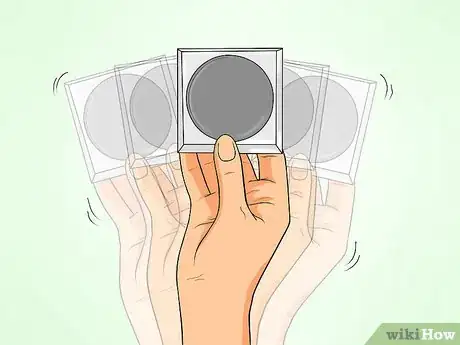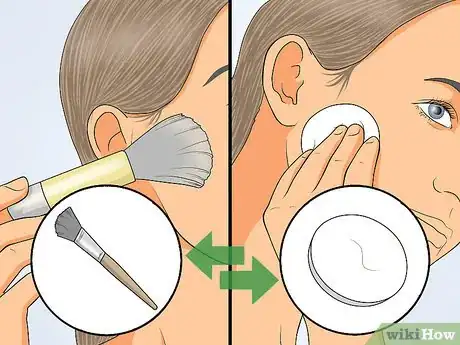This article was co-authored by Kelly Chu. Kelly is the lead makeup artist and educator of the Soyi Makeup and Hair team that is based in the San Francisco Bay Area. Soyi Makeup and Hair specializes in wedding and event makeup and hair. Over the past 5 years, the team has created bridal looks for over 800 brides in America, Asia, and Europe.
This article has been viewed 15,332 times.
Blurring powder is a powder that can be used to set your regular makeup. It can help further conceal problem areas and leave your skin looking flawless, especially under harsh light. You pat blurring powder on after applying your regular makeup. You should especially target things like pores and places where your skin is patchy or uneven. Be careful when using blurring powder, however, as it may cause skin irritation. Stop using blurring powder if it bothers your skin.
Steps
Applying Blurring Powder Effectively
-
1Apply blurring powder after your regular makeup. Blurring powder is generally used to enhance existing makeup and help further smooth over any inconsistencies in your skin tone. Before applying blurring powder, put on your makeup as you regularly would. Once you're finished with your normal makeup routine, you can apply the powder as necessary.[1]
-
2Shake the container to loosen the powder. Blurring powder sometimes gets stuck on the bottom of the container. This is especially true if the container is new. To loosen the powder for use, shake the container lightly before opening it. When opened, there should be a light layer of blurring powder on top of the container.[2]Advertisement
-
3Pat it on your face using a brush or pad. Dab a pad or makeup brush into the container, getting a light dusting of blurring powder on the pad or brush. Then, gently dab the powder onto your face. Use brief, patting motions throughout your face to apply the powder. You should apply a layer of blurring powder over all your regular makeup. This should make your makeup look more even.[3]
- If your makeup looks particularly uneven or sparse in certain areas, target these areas a little more when applying blurring powder.
- Make sure to use gentle motions. Moving too fast can cause blurring powder to create dust, which can cause sneezing and coughing.[4]
-
4Do another layer if necessary. After you're done applying powder, examine your face. Some blurring powder is very sheer, and your face may not look much different after the first layer. If you believe it is necessary, add another layer of blurring powder. You can also simply add a layer on areas that look particularly sparse, like your chin or forehead.[5]
Targeting Specific Issues with Blurring Powder
-
1Erase pores with blurring powder. Blurring powder is generally applied after your regular makeup. However, if you have large pores around certain areas, like your nose or chin, blurring powder can be used to diminish their effect. It can create a smooth surface on your skin before applying regular makeup, which can seep into pores and make them more noticeable.[6]
- If you have pores you want to conceal, add a layer of blurring powder over areas where pores appear. Then, apply your regular makeup.
-
2Conceal troublesome areas. Things like inconsistency in skin tone and wrinkles are easier to conceal with blurring powder than other cosmetic products. Blurring powders are designed to create an airbrush effect similar to something like Photoshop. If you have problem areas, dust a layer of blurring powder over these areas before applying your regular makeup.[7]
-
3Use blurring powder when you'll be under harsh light. You do not necessarily need to use blurring powder for an every day look. It can take awhile to apply and may not be necessary in some circumstances. However, if you're going to be under harsh, bright lights, blurring powder can give an extra boost to your regular makeup, better concealing imperfections.[8]
- For example, use blurring powder if you're going to be out in the sun all day.
-
4Apply blurring powder to your lips. If you want matte lips, but do not want to pay the extra money for supplies, blurring powder can be used to create the effect. Use a glossy lipstick. Then, blot on some blurring powder with a piece of tissue. Keep blotting until you reach your desired effect.[9]
Avoiding Common Pitfalls
-
1Switch up your tools if necessary. Blurring powder can create dust when applied. Different powders may respond better to different tools. If your blurring powder scatters while you're applying a layer, try switching up tools to see if this helps. For example, switch from using a makeup pad to a brush.[10]
-
2Do not use blurring powder on irritated or damaged skin. If your skin is burnt, damaged, or otherwise irritated, do not try to cover this with blurring powder or any makeup. Allow damaged skin to heal completely before concealing it with makeup.[11]
-
3Stop using if you notice a bad reaction. If you've never used a product before, there is always a risk of a bad reaction. Stop using blurring powder and talk to a doctor if you notice any of the following:[12]
- Red blotches
- Swelling
- Itchiness
- Irritation
-
4Store your powder correctly. Blurring powder should be kept out of reach of children and pets. You should also keep it out of direct sunlight. Store it in a location that is regular room temperature. Extreme heat or extreme cold can damage blurring powder.[13]
Expert Q&A
-
QuestionWhat kind of brush is best for blurring powder?
 Kelly ChuKelly is the lead makeup artist and educator of the Soyi Makeup and Hair team that is based in the San Francisco Bay Area. Soyi Makeup and Hair specializes in wedding and event makeup and hair. Over the past 5 years, the team has created bridal looks for over 800 brides in America, Asia, and Europe.
Kelly ChuKelly is the lead makeup artist and educator of the Soyi Makeup and Hair team that is based in the San Francisco Bay Area. Soyi Makeup and Hair specializes in wedding and event makeup and hair. Over the past 5 years, the team has created bridal looks for over 800 brides in America, Asia, and Europe.
Professional Makeup Artist Try a fan brush. A fan brush is perfect for gently dusting on a product like blurring powder because it gives you a soft look. Sweep the powder on your face, then use the gently blend and diffuse it. You can also use the brush to gently wipe away excess powder from your face.
Try a fan brush. A fan brush is perfect for gently dusting on a product like blurring powder because it gives you a soft look. Sweep the powder on your face, then use the gently blend and diffuse it. You can also use the brush to gently wipe away excess powder from your face. -
QuestionWhen should I use cleanser?
 Community AnswerIdeally, you should use cleanser when you are washing your face at night before bedtime.
Community AnswerIdeally, you should use cleanser when you are washing your face at night before bedtime.
References
- ↑ https://www.youtube.com/watch?v=vBDZgXN6GF8
- ↑ https://www.youtube.com/watch?v=vBDZgXN6GF8
- ↑ https://www.youtube.com/watch?v=vBDZgXN6GF8
- ↑ https://www.youtube.com/watch?v=hwDIvnqWerE
- ↑ https://www.youtube.com/watch?v=vBDZgXN6GF8
- ↑ https://www.birchbox.com/magazine/article/blur-makeup-trend
- ↑ https://www.birchbox.com/magazine/article/blur-makeup-trend
- ↑ https://www.birchbox.com/magazine/article/blur-makeup-trend
- ↑ https://blog.honestbeauty.com/5-tips-tricks-with-our-new-invisible-blurring-powder/































































